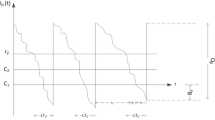Abstract
In order to explore the feasibility of using deep learning in the Wise Information Technology of 120 (WIT120) material distribution system under deep learning, in the study, first, the Hopfield neural network and simulated annealing (SA) algorithm are used to study the path optimization in the WIT120 material distribution system. Aiming at the poor optimization and robustness of the traditional Hopfield neural network and the low optimization efficiency of SA algorithm, in this study, a memory device is added to the SA algorithm, the distribution starting points of the two algorithms are fixed, and an improved hybrid algorithm is designed by combining Hopfield neural network and SA algorithm. Then, the improved hybrid algorithm of the traditional Hopfield neural network and SA algorithm is used in the actual medical material distribution system, and comparative analysis of the distribution route, cost, and scheduling time before and after using the proposed algorithm is performed. Besides, the difference between the proposed algorithm and other algorithms in path optimization and path planning efficiency is compared and analyzed. The results show that the improved hybrid algorithm proposed in this research reduces the total mileage of distribution by 46.9%, costs by 33.9%, and the time required for scheduling by 99% after applied in the medical material distribution system. It is also better than traditional analog algorithms and neural networks in distribution path optimization. The path optimization results show that the shortest path produced by the improved hybrid algorithm in this study is 27.85, which is superior to the traditional SA algorithm, Hopfield neural network, and genetic algorithm (the shortest paths obtained are 41.21, 44.63 and 36.48, respectively). Compared with other optimization algorithms, the path planning efficiency of the hybrid algorithm is the highest (the amount of distribution tasks completed in unit time is 22). In conclusion, the improved hybrid algorithm proposed in this study can effectively reduce distribution costs, shorten transportation routes, and improve optimization efficiency, indicating that the hybrid algorithm proposed in this study is effective and practical when applied in the medical material distribution system, which can provide reference value for medical material distribution and provide data support for the management of medical material distribution.





Similar content being viewed by others
References
Katwa U, Rivera E (2018) Asthma management in the era of smart-medicine: devices, gadgets, apps and telemedicine. Indian J Pediatrics 85:757–762
Briga, Mullin, Brett et al (2019) Material need insecurity and its concurrent barriers to diabetes management among low-income Latino adults receiving medical care. Diabetes Care 42(3):e31–e33.
Zhou QS, Olsen TL (2017) Inventory rotation of medical supplies for emergency response. Eur J Oper Res 257(3):810–821
Li H, Peng J, Li S et al (2017) Dispatching medical supplies in emergency events via uncertain programming. J Intell Manuf 28(3):549–558
Kang S, Kim SS, Won J et al (2016) GPU-based parallel genetic approach to large-scale travelling salesman problem. J Supercomp 72(11):4399–4414
Tayarani NMH, Adam PB (2016) An analysis of the fitness landscape of travelling salesman problem. Evolut Comp 24(2):347–384
Lyden S, Haque ME (2016) A simulated annealing global maximum power point tracking approach for PV modules under partial shading conditions. IEEE Trans Power Electron 31(6):4171–4181
Joudar NE, En-Naiman Z, Ettaouil M (2019) Using continuous Hopfield neural network for solving a new optimization architecture model of probabilistic self organizing map. Neurocomputing 344:82–91.
Su YF (2019) Integrating a scale-invariant feature of fractal geometry into the Hopfield neural network for super-resolution mapping. Int J Remote Sens 40(23):1–22
Suhit AK, Arka D, Arockia DAS (2017) A comparative study between Hopfield neural network and A* path planning algorithms for mobile robot, pp 517:33–48.
García L, Talaván PM, Yanez J (2017) Improving the Hopfield model performance when applied to the traveling salesman problem. Soft Comput 21(14):3891–3905
Pan Q, Wang X (2017) Independent travel recommendation algorithm based on analytical hierarchy process and simulated annealing for professional tourist. Appl Intell 48:1565–1581
Sheng L, Qian SQ, Ye YQ et al (2016) An improved immune algorithm for optimizing the pulse width modulation control sequence of inverters. Eng Optim 22:1463–1482
Jafarzadeh H, Moradinasab N, Elyasi M (2017) An enhanced genetic algorithm for the generalized traveling salesman problem. Eng Technol Appl Sci Res 7(6):2260–2265
Piryonesi SM, Nasseri M, Ramezani A (2019) Resource leveling in construction projects with activity splitting and resource constraints: a simulated annealing optimization. Can J Civ Eng 46(2):81–86
Sayin A, Hoare EG, Antoniou M (2020) Design and verification of reduced redundancy ultrasonic MIMO arrays using simulated annealing & genetic algorithms. IEEE Sens J 99:1–1
Njitacke ZT, Matze CL, Tsotsop MF et al (2020) Remerging Feigenbaum trees, coexisting behaviors and bursting oscillations in a novel 3D generalized Hopfield neural network. Neural Process Lett, pp 1–23
Akhmet M, Alejaily EM (2019) Domain-structured Chaos in a Hopfield neural network. Int J Bifurcation Chaos 29(14):333–340
Kirci P (2016) An optimization algorithm for a capacitated vehicle routing problem with time windows. Sadhana 41(5):519–529
Bagherlou H, Ghaffari A (2018) A routing protocol for vehicular ad hoc networks using simulated annealing algorithm and neural networks. J Supercomp 74:2528–2552
Acknowledgements
This work was supported by philosophy and social science planning project of Heilongjiang Province (18JYB145 and 18JYH753) and General project of National Social Science Fund (19BJY153).
Author information
Authors and Affiliations
Corresponding author
Additional information
Publisher's Note
Springer Nature remains neutral with regard to jurisdictional claims in published maps and institutional affiliations.
Rights and permissions
About this article
Cite this article
Tang, S., Zhao, H., Wang, Z. et al. Analysis of the material distribution system of wise information technology of 120 under deep learning. J Supercomput 77, 9988–10002 (2021). https://doi.org/10.1007/s11227-021-03646-2
Accepted:
Published:
Issue Date:
DOI: https://doi.org/10.1007/s11227-021-03646-2




